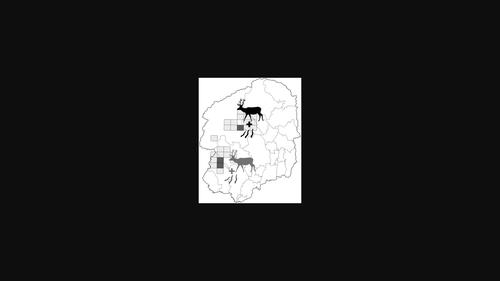当前位置:
X-MOL 学术
›
Ecol. Res.
›
论文详情
Our official English website, www.x-mol.net, welcomes your
feedback! (Note: you will need to create a separate account there.)
Concordant genetic structures of sika deer and Japanese land leeches suggest that the current range expansion of Haemadipsa japonica is dependent on sika deer migration: A case study from Tochigi Prefecture, Japan
Ecological Research ( IF 1.7 ) Pub Date : 2022-10-27 , DOI: 10.1111/1440-1703.12366 Kaori Morishima 1 , Emiko Fukui 2 , Mineaki Aizawa 3
Ecological Research ( IF 1.7 ) Pub Date : 2022-10-27 , DOI: 10.1111/1440-1703.12366 Kaori Morishima 1 , Emiko Fukui 2 , Mineaki Aizawa 3
Affiliation

|
Haemadipsa japonica is a Japanese land leech that feeds on the blood of host animals, mainly the sika deer (Cervus nippon). The distribution of H. japonica has expanded since the 1990s, possibly due to sika deer population increases. Haemadipsa japonica populations were found in the northern and southern regions of Tochigi Prefecture, central Japan. Previous investigations reported that these populations are genetically differentiated between the north and south, although the sika deer distribution extends throughout the northern and southern regions. We hypothesized that the migration of sika deer might be limited, thus maintaining the two H. japonica genetic groups and restricting its range expansion. We evaluated this hypothesis by investigating the genetic structure of the mitochondrial DNA (mtDNA) and nuclear microsatellites (nSSR) of sika deer samples collected from Tochigi Prefecture and from H. japonica bloodmeal samples (invertebrate-derived DNA; iDNA). The sika deer mtDNA presented two haplotypes (G- and A-haplotypes) without a clear genetic structure. Conversely, the sika deer nSSR analysis indicated clear genetic differentiation between deer in the northern and southern regions, corresponding to the two H. japonica genetic groups. This indicates that sika deer movement is restricted to narrow regions in Tochigi Prefecture. Therefore, we conclude that the current H. japonica expansion in the prefecture likely depends on the migration of sika deer, only occurring within the northern and southern regions, even though this is driven by sika deer migration.
中文翻译:

梅花鹿和日本陆蛭的一致遗传结构表明,目前刺血吸虫的范围扩张依赖于梅花鹿的迁徙:来自日本栃木县的案例研究
Haemadipsa japonica是一种日本陆蛭,以寄主动物(主要是梅花鹿 ( Cervus nippon ))的血液为食。H. japonica的分布自 1990 年代以来有所扩大,这可能是由于梅花鹿数量增加所致。在日本中部栃木县的北部和南部地区发现了Haemadipsa japonica种群。先前的调查报告称,尽管梅花鹿的分布范围遍及整个北部和南部地区,但这些种群在基因上存在南北差异。我们假设梅花鹿的迁徙可能受到限制,从而维持了两种H. japonica遗传群体和限制其范围扩大。我们通过研究从栃木县和H. japonica bloodmeal 样本(无脊椎动物衍生的 DNA;iDNA)收集的梅花鹿样本的线粒体 DNA (mtDNA) 和核微卫星 (nSSR) 的遗传结构来评估这一假设。梅花鹿线粒体DNA呈现出两种没有明确遗传结构的单倍型(G-和A-单倍型)。相反,梅花鹿 nSSR 分析表明北部和南部地区的鹿之间存在明显的遗传分化,对应于两个H. japonica遗传组。这表明梅花鹿的活动仅限于栃木县的狭窄区域。因此,我们得出结论,目前的H. japonica该县的扩张可能取决于梅花鹿的迁徙,尽管这是由梅花鹿迁徙驱动的,但只发生在北部和南部地区。
更新日期:2022-10-27
中文翻译:

梅花鹿和日本陆蛭的一致遗传结构表明,目前刺血吸虫的范围扩张依赖于梅花鹿的迁徙:来自日本栃木县的案例研究
Haemadipsa japonica是一种日本陆蛭,以寄主动物(主要是梅花鹿 ( Cervus nippon ))的血液为食。H. japonica的分布自 1990 年代以来有所扩大,这可能是由于梅花鹿数量增加所致。在日本中部栃木县的北部和南部地区发现了Haemadipsa japonica种群。先前的调查报告称,尽管梅花鹿的分布范围遍及整个北部和南部地区,但这些种群在基因上存在南北差异。我们假设梅花鹿的迁徙可能受到限制,从而维持了两种H. japonica遗传群体和限制其范围扩大。我们通过研究从栃木县和H. japonica bloodmeal 样本(无脊椎动物衍生的 DNA;iDNA)收集的梅花鹿样本的线粒体 DNA (mtDNA) 和核微卫星 (nSSR) 的遗传结构来评估这一假设。梅花鹿线粒体DNA呈现出两种没有明确遗传结构的单倍型(G-和A-单倍型)。相反,梅花鹿 nSSR 分析表明北部和南部地区的鹿之间存在明显的遗传分化,对应于两个H. japonica遗传组。这表明梅花鹿的活动仅限于栃木县的狭窄区域。因此,我们得出结论,目前的H. japonica该县的扩张可能取决于梅花鹿的迁徙,尽管这是由梅花鹿迁徙驱动的,但只发生在北部和南部地区。













































 京公网安备 11010802027423号
京公网安备 11010802027423号